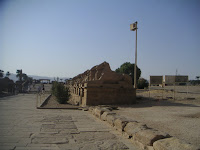One of the intriguing statues was to Akhenaten, a pharaoh who tried to transform the spiritual beliefs of the country by declaring that there was only one god. He also tried to change the form of representation, insisting on realism in portrayal, rather than the idealized and stylized images of his ancestors. As a result, the faces of statues display emotion, and bodies are not perfectly proportioned.
There is a avenue between the site of the Luxor Museum and Karnak temple known as the Avenue of the Sphinx. Statues of the Sphinx lined both sides of the avenue. Recent excavations in the area have revealed their presence and efforts to bring this avenue back to its original majesty are currently in progress. Since the statues were several metres underground, buildings have been demolished, peoples' homes have been destroyed and residents have been moved to other areas of the city.
My camera captured some of the elements of the potential site--the line of Sphinxes already excavated, the king standing between the paws of the sphinx, and the head of the ram.
The river portion of our Royal Egypt included 26 people. Only 2 other people joined us for the land portion in Alexandria and Cairo.
The tour was entitled the Royal Egypt; the boat had been built by King Farouk. Our hotel in Alexandria was a former hunting lodge built by King Farouk. Many pieces of furniture in the lobby and restaurants were used by the royal family. The lodge overlooks the Mediterranean and is situated in the midst of a large garden. The view from our window--
We toured Alexandria in a small van, stopping to view a Coptic Christian church, the newly built library at Alexandria, the Catacombs, and the Roman Theatre. Traffic was unbelievable and driving habits were extremely interesting. Three lanes of traffic were delineated on the pavement but at least 6 lanes of cars, busses, and cycles jockey for position. Street lights were few and separated by several hundred metres. When drivers tried to enter the main street from the side streets, they honked and gestured. Drivers on the main street allowed them to enter,causing even more congestion.
Our travel companions were very interested in architecture and art and had requested a tour of several churches and mosques. Our guide, Waleed, arranged a tour of the Coptic Church in Alexandria.
An exterior view of the church, hidden along a small alley, too narrow for our van. We had navigated through what seemed to be a maze of streets and then stopped at the end of the alley. Our guide jumped out and beckoned us to follow him. We rounded a few corners and entered a small square to fin
 |
| The interior of the church |
I was most impressed with the newly constructed Biblioteka Alexandrina, a complex designed by a Norwegian firm of architects. The link describes the various aspects of the buildings. The galleries, reading rooms, permanent displays were buzzing with activity; the site is definitely well used by native Egyptians as well as by visitors. We wandered through the complex for several hours and arranged a return visit the next day.
We also visited the catacombs and an excavation site of a RomanTheatre. Our stay in Alexandria ended with a tour of the catacombs, followed by lunch in an exquisite fish restaurant overlooking the Mediterranean Sea.
 |
| Pyramid of Cheops, from our hotel room. |
Cairo was much busier and dustier. From the balcony of our room, we could see two large pyramids. We visited the three pyramids of Giza, spending several hours at the site, clambering over the walls, and entering part of the tomb. We could not venture anywhere in Egypt without meeting the tourist police (yes, that is what they are called). They guarded the entrance to tourist sites, ensuring that visitors did not touch the statues, walls of the temples. Nowhere, however, did the police provide such an image as outside the pyramids. The man, camel and mud brick wall . . .
 |
| the mosque |
 |
| the ablution fountain |
The last stop on our tour was the Alabaster Mosque, built as part of the Citadel during the time of the Ottoman empire. Our guide demonstrated the great acoustic properties of the dome by singing a prayer. The sound seemed to circle around the dome, returning to us in a new form.
Our Royal Egypt tour was a wonderful experience but we were pleased when we arrived back in Torquay.




















